Clouds in Art—Stratus, Cumulus, Cirrus, and Many More!
Clouds in art are why the term “landscape painting” is a bit deceiving. It suggests that the subject of the artwork is the land, and yet it is...
Sandra Juszczyk 25 July 2024
Artists have frequently critiqued, celebrated, and commented on the role of sellers, shedding light on the multifaceted role commerce plays in shaping human societies and identities. These depictions often reflect not only the economic transactions, but also the broader societal implications, such as the disparity between rich and poor, the power dynamics in business, and the impact of consumer culture.
From the bustling market scenes of the Dutch Golden Age paintings by artists like Johannes Vermeer and Jan Steen to the iconic Wall Street scenes of American Realism by artists such as George Bellows, commerce in various forms has frequently been depicted by artists of various schools. Here are 10 paintings that capture the essence of commerce.
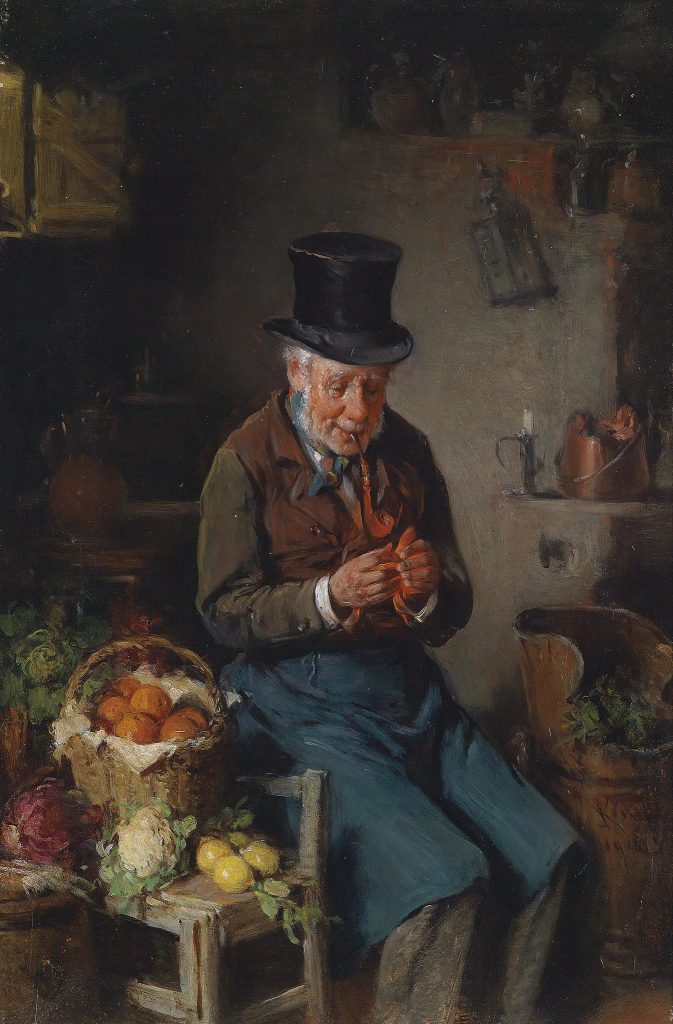
Hermann Kern, The Greengrocer (Der Gemüsehändler), ca. 1906, private collection. Artnet.
Hermann Kern was a German painter whose works from the late 19th and early 20th centuries are a window into everyday life in rural Germany. Kern had a special focus on depicting peasants engrossed in their daily routines. His art is marked by its realistic portrayal and meticulous attention to detail, offering valuable insights into the social and cultural dynamics of a bygone era.
In one of his notable pieces, Kern immortalizes an aged seller amidst his modest produce, perhaps taking a moment’s respite between tending to customers. The warm, flickering glow of the fire casts a warmth upon his hands as he kindles his pipe. This scene encapsulates a sense of simplicity and nostalgia, skillfully conveying the challenges inherent in rural living.

Antonio Ermolao Paoletti, Flowers at Your Door, ca. 19th century, private collection. Artnet.
Antonio Ermolao Paoletti was an Italian painter who made significant contributions to the art world during the 19th century. Known for his talent and versatility, his work comprised historical and genre painting, landscapes, and portraiture. Included in his works is a body of work depicting sellers of various commodities and the portrayal of commerce in progress in the streets of Venice, Italy. These works offered a glimpse into the socioeconomic fabric of 19th-century Italy and showcased Paoletti’s great talent in elevating a seemingly ordinary scene into a work of art.
Paoletti captured on canvas the nuances of the everyday life of sellers of all ages and a variety of products such as melons, chestnuts, fruits, or flowers. Their expressions and body language convey a sense of authenticity.
This painting epitomizes warmth by the use of natural light, which accentuates the backdrop and conveys a sense of familiarity. The artist’s skill in portraying the play of light and shadow adds depth to the composition and contrasts against the rich colors of the flowers and plants on sale.
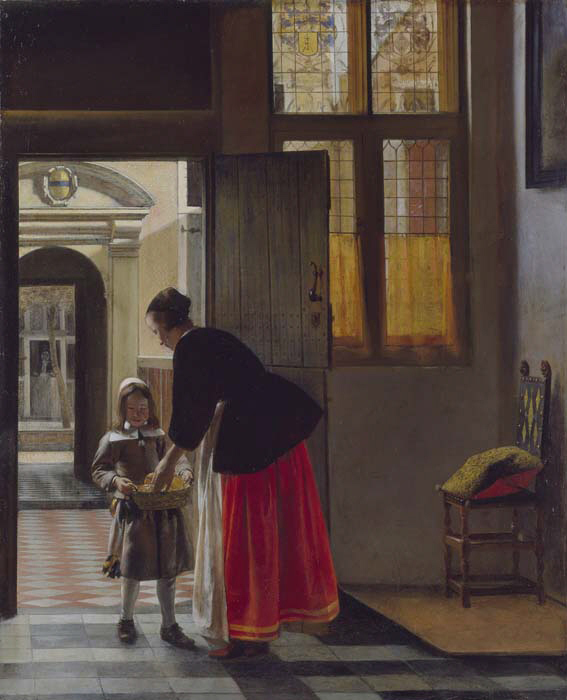
Pieter de Hooch, A Boy Bringing Bread, ca. 1663. Wallace Museum, London, UK.
Created around the early 1660s, this Pieter de Hooch painting exemplifies his expertise in capturing the domestic scenes of women and children, a theme for which he is renowned. Additionally, his artworks served as a visual chronicle of fashionable life in Amsterdam during the 17th century, distinguished by de Hooch’s use of a darker and richer color palette.
Notable in the painting is a young seller standing at the threshold of an elegant home with high ceilings, presenting a basket of rolls of bread to a well-dressed lady wearing a vibrant red skirt.
De Hooch’s mastery lies in the portrayal of great depth, as a tiled courtyard leads into a shadowy interior adorned with a coat of arms. The focus in this painting is on the verticality of the architecture that guides the viewer’s gaze upward, drawing attention to the tall ceilings and stained glass windows.
In the distant background, ghostly outlines of another woman add an element of mystery, perhaps the boy’s mother discreetly observing the transaction. This simple scene carries a palpable sense of mystery imbibed into a simple commercial transaction.
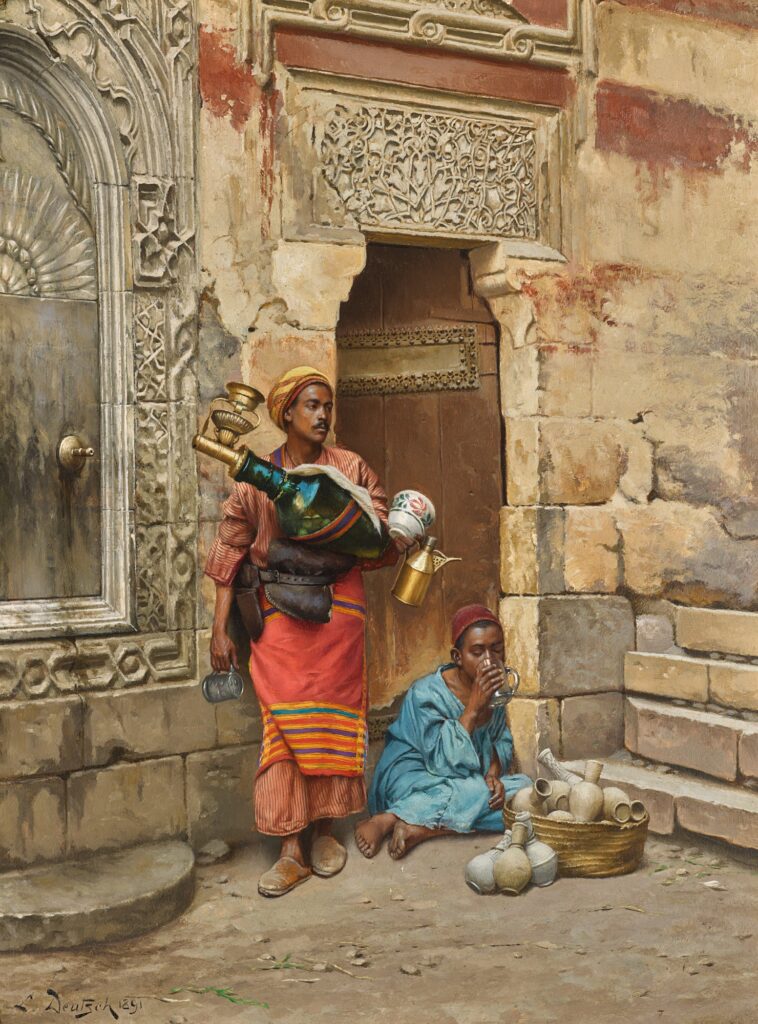
Ludwig Deutsch, Water Seller, ca. 1891, private collection. Sotheby’s.
Ludwig Deutsch was an Austrian painter hailing from Vienna, who made Paris his home and garnered recognition as a distinguished Orientalist artist. His keen attention to detail became a hallmark of his intricate works.
In the 19th century, Cairo relied on an elaborate network of canals and aqueducts to provide fresh water that was dispensed at public wells or traditional sebils throughout the city. Yet, in times of drought or for those unable to access these facilities, the indispensable role of water sellers became apparent.
Living as a European in Egypt, Deutsch was particularly intrigued by the distinctive features of Cairene society and appreciated the pivotal role played by water sellers. These sellers employed water sacks crafted from animal skin or glass to transport the water and distribute it directly to homes.
In this painting by Deutsch, a water seller stands poised outside a doorway, showcasing his wares in an intricate vessel made of iridescent teal glass strapped across his chest. At his feet, either a customer or an assistant delicately sips water from a glass, underscoring the significance of the water seller in the daily lives of the community.
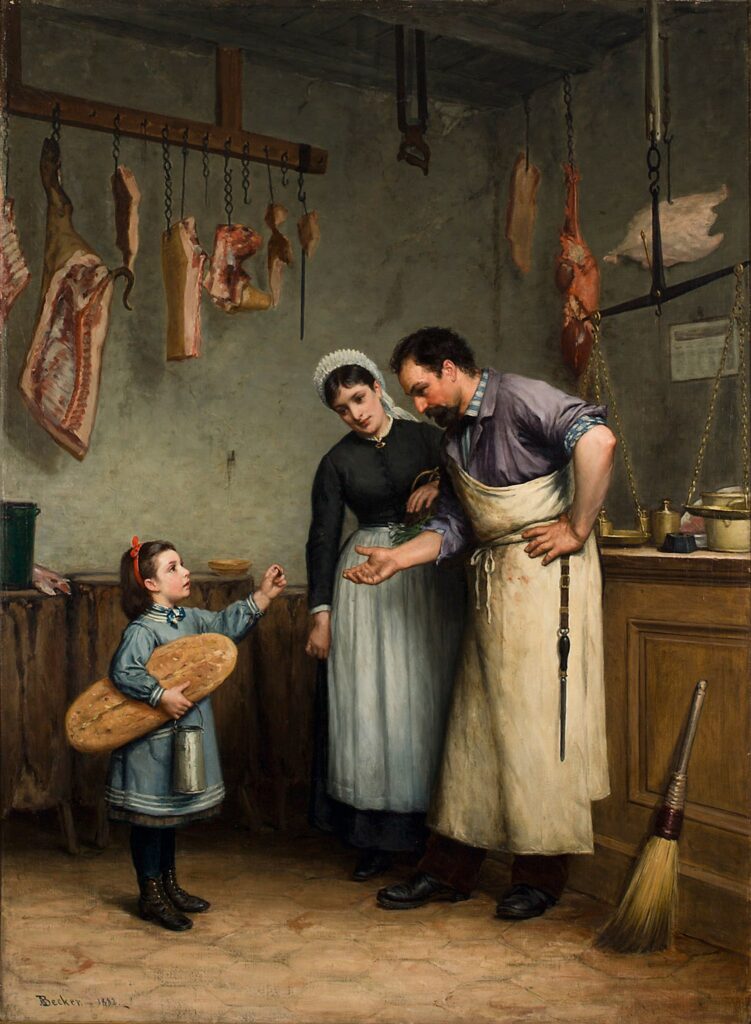
Adolf von Becker, Something for the Cat, ca. 1882, Finnish National Gallery, Helsinki, Finland.
Born in Saint Petersburg, Russia, Adolf von Becker initially began his artistic journey at the Imperial Academy of Arts before refining his skills in Düsseldorf and Paris. He was a pivotal figure in Finnish art during the late 19th and early 20th centuries and one of the first Finnish artists to study in Paris. He also served as a mentor to many young artists of the Golden Age of Finnish Art.
Von Becker’s artistic prowess was characterized by a versatile approach to genre scenes, historical subjects, and portraits. Known for his meticulous attention to detail and a keen understanding of form and color, his legacy remains influential.
In this painting by von Becker, a captivating scene unfolds as a young child visits a butcher. The room is surrounded by an array of meat cuts, clearly indicating the occupation of the proprietors. The close contact between the two adults suggests a familiar relationship between them, possibly that of a spouse.
The young girl, with her shopping in tow, seems to have traversed the dairy and the bakery before reaching the butcher. The expressions of endearment on the faces of the butcher and his companion convey their interest and amusement in their young customer as they momentarily halt their work to engage in a business transaction with her. Titled Something for the Cat, the artwork hints at the intended recipient of the girl’s purchase—a beloved feline companion.
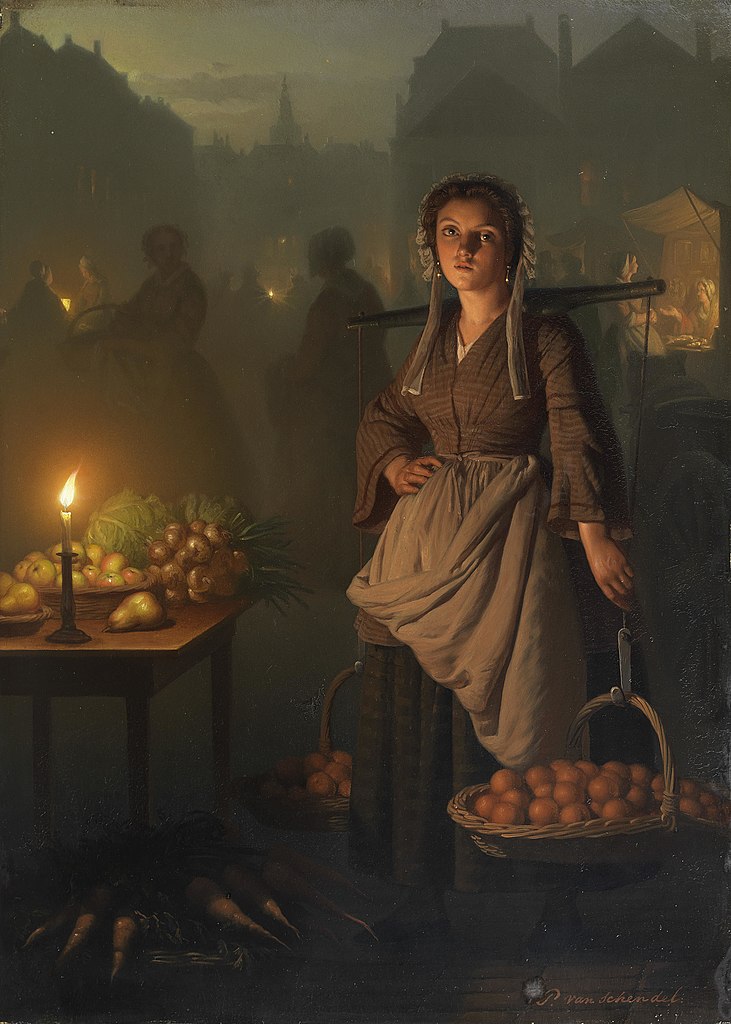
Petrus van Schende, Market by Candlelight, ca. 1865, private collection. Wikimedia Commons (Public Domain).
Petrus Van Schendel, a Dutch-Belgian painter trained in Antwerp, achieved acclaim for his expertise in depicting historical subjects. His most celebrated works, the ‘nocturnes,’ showcase scenes illuminated by candlelight and moonlight, drawing inspiration from the 17th-century northern masters of light, the Utrecht Caravaggisti.
One such vibrant composition unfolds at The Hague’s ‘Groenmarkt,’ the farmers’ market. The scene’s illumination, derived from oil lamps, candles, and a hint of moonlight, adds complexity and a sense of foreboding to this painting that is emphasized by the many figures throughout the canvas that are obscured by the heavy mist.
The foreground features a solitary candle that accentuates the hyper-realistic gaze of the young seller and her wares. Her expression depicts a sense of melancholy, possibly reflecting the toil of her labor as she transports undoubtedly heavy produce to her stall.
The depictions of the produce are expertly conveyed and unambiguously discernible through the glow of the candlelight. Van Schendel’s mastery of light and shadows is evident in the meticulous and hyper-realistic definition of the artworks and the vibrant colors of the stall, teeming with fresh vegetables.
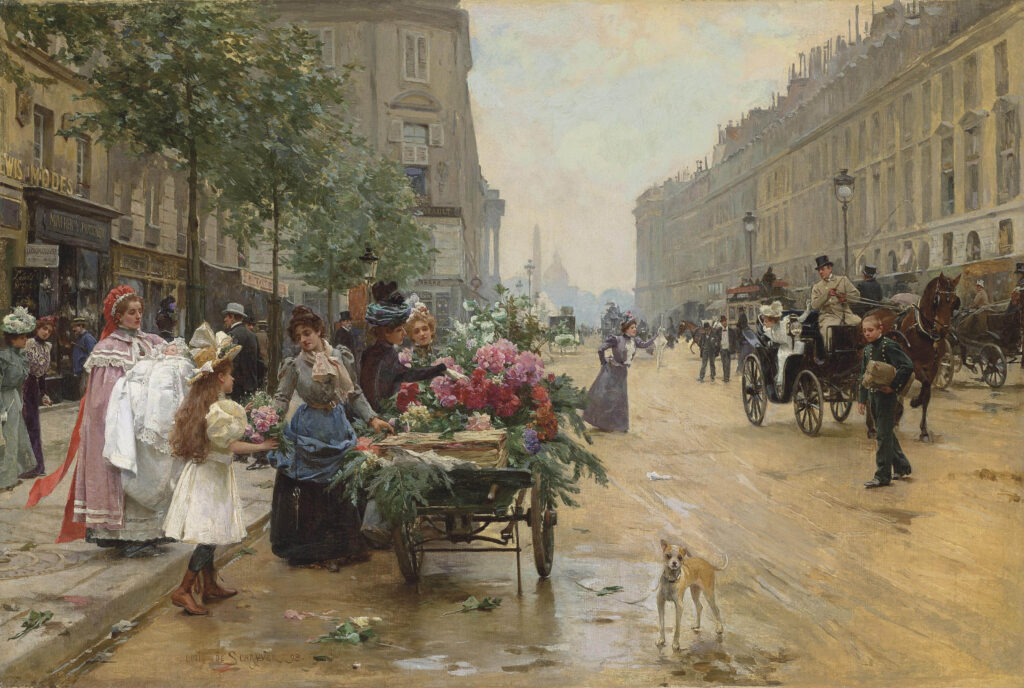
Louis Marie de Schryver, Rue Royale, Paris, ca. 1898, Private Collection via Christie’s.
Louis Marie de Schryver, born in Paris to a well-established journalist father, displayed early artistic promise, commencing his training as an artist by the age of 12. At just 13, he exhibited his first works at the Salon in 1876, depicting still lifes featuring flowers.
Much of his oeuvre provides a glimpse into the elegant life of the privileged class in turn-of-the-century Paris, portraying grand boulevards teeming with life and activity, and featuring fashionably dressed women chauffeured around in horse-drawn carriages.
Recognizable by monuments featured in the distance, this painting features the fashionable boulevard Rue Royale in Paris, capturing the essence of the city’s most famous streets that are adorned with luxury shops and stylish restaurants. In the background, various figures contribute to the hustle and bustle, and a single dog pauses at the canvas’s lower edge, adding another narrative layer to the composition.
Noteworthy is the painting’s focus on the street’s fashionable character, symbolized by a shop sign bearing the word ‘Modes’ (‘Fashions’) in the upper left corner. Below, two women in elaborate ensembles advertise what is no doubt their latest and most sought-after fashions.
At the very center of the composition is a burst of exuberant flowers that spills over its seller’s cart, drawing in a young buyer as her governess looks on.
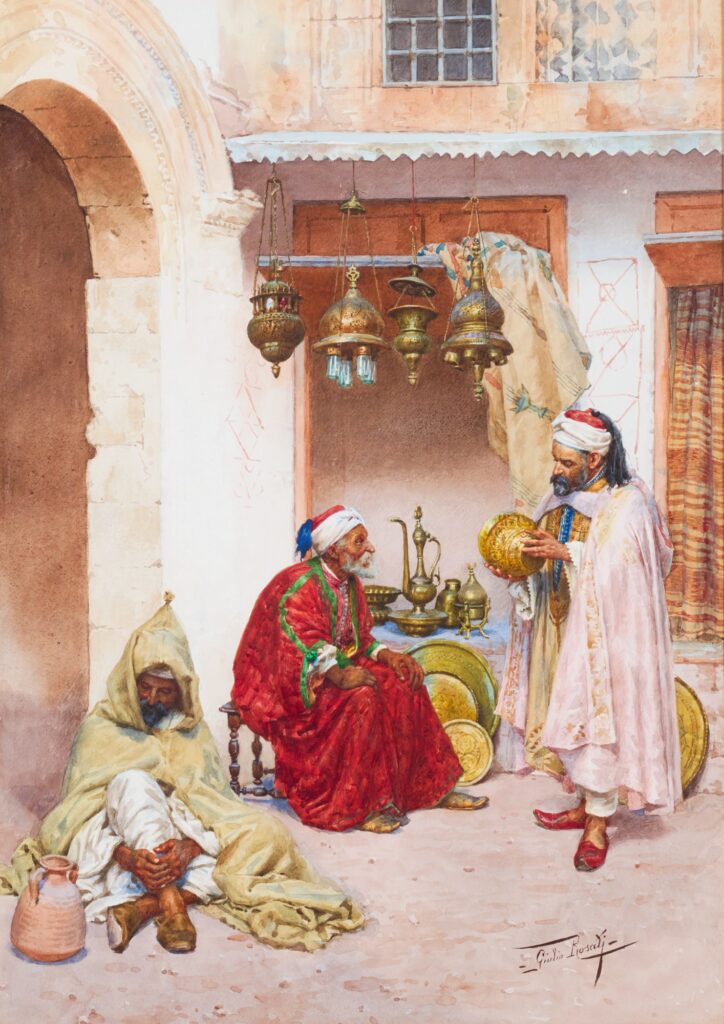
Giulio Rosati, In the Souk, ca. 19th century, private collection. Sotheby’s.
Giulio Rosati was a Roman-born Italian painter who specialized in Orientalist and historical subjects. After formal training at the Accademia di San Luca in Roma, he delved into the 19th-century European fascination for Orientalist themes.
Rosati expertly infused great depth into his work by employing vibrant hues and capturing intricate details of the North African aesthetic. He brought to life the cultural nuances of North Africa and the Near East through his focus on genre paintings that depicted everyday life, bustling markets, and ceremonial events in the region with careful attention to costume, architecture, and the general atmosphere. Through this, Rosati provided viewers with a romanticized glimpse into distant cultures, contributing to the enduring appeal of his oeuvre.
In this specific work, an aging brass seller is portrayed by Rosati, seated in front of his modest shop that is adorned with exquisite brass lanterns, ewers, trays, and assorted decorative brassware. The tired aging seller is accompanied by a young interested buyer carefully examining one of the brass wares. The bright, almost blinding light of the day, the sleeping man in the foreground, and the evident expression of fatigue on the seller’s face evoke an overall sense of weariness in this painting, perhaps intended to depict the late afternoon slump.
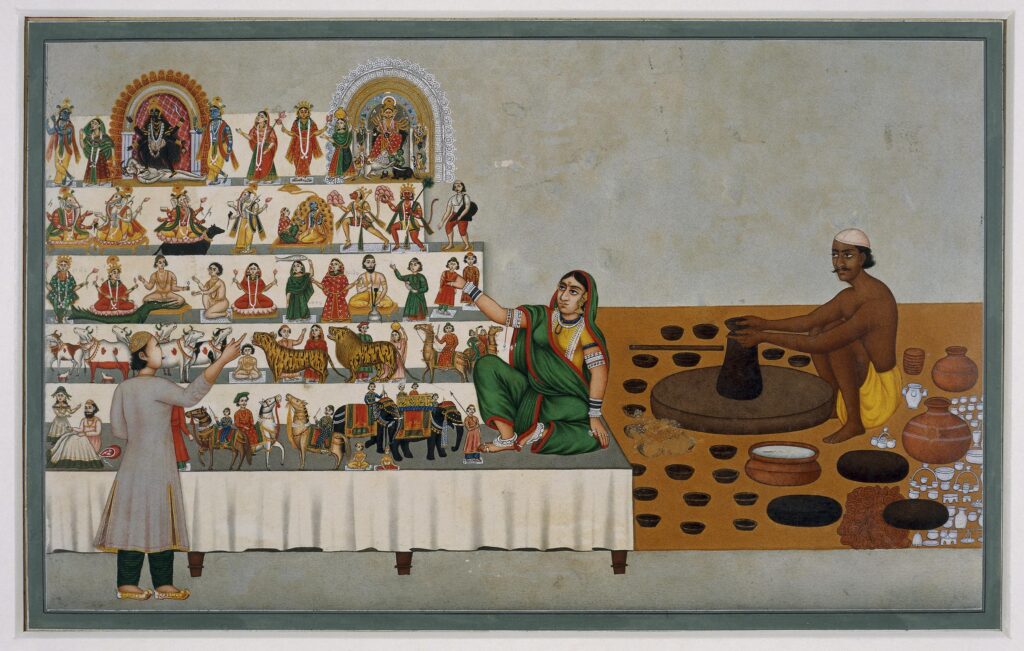
Attributed to Siva Dayal Lal, Stall for the Sale of Painted Figures, a Painting in the Company Style, ca. 1870, the British Museum, London, UK.
In this gouache painting on paper, a vibrant market stall on the left side depicts richly adorned thematic figurines known as golu. These figures include representations from Hindu texts and religious images, including the depictions of Hindu Gods and Goddesses, warriors, attendants, cows, and tradespeople. The sale of golu suggests the onset of the autumn festive season of Navaratri, likely in South India.
The seller of the golu is dressed in a green sari with a yellow blouse and appears seated on the first tier of the stall, peddling her wares. The abundance of jewelry on her neck, arms, ankles, and wrists not only adds to her personal adornment but also signifies her status and, possibly, the success of her enterprise.
An interested buyer examines the wares in front of her stall, while to the right, a bare-chested potter works at his wheel, surrounded by the fruits of his labor.
This painting is believed to be attributed to Shiva Dayal Lal, a late 19th-century artist associated with the Patna School of Painting in Northern India. The painting reflects his mastery in creating scenes of contemporary life, which he did for a diverse clientele, both European and Indian. Active around 1870, Lal left a lasting imprint on the art of the time.
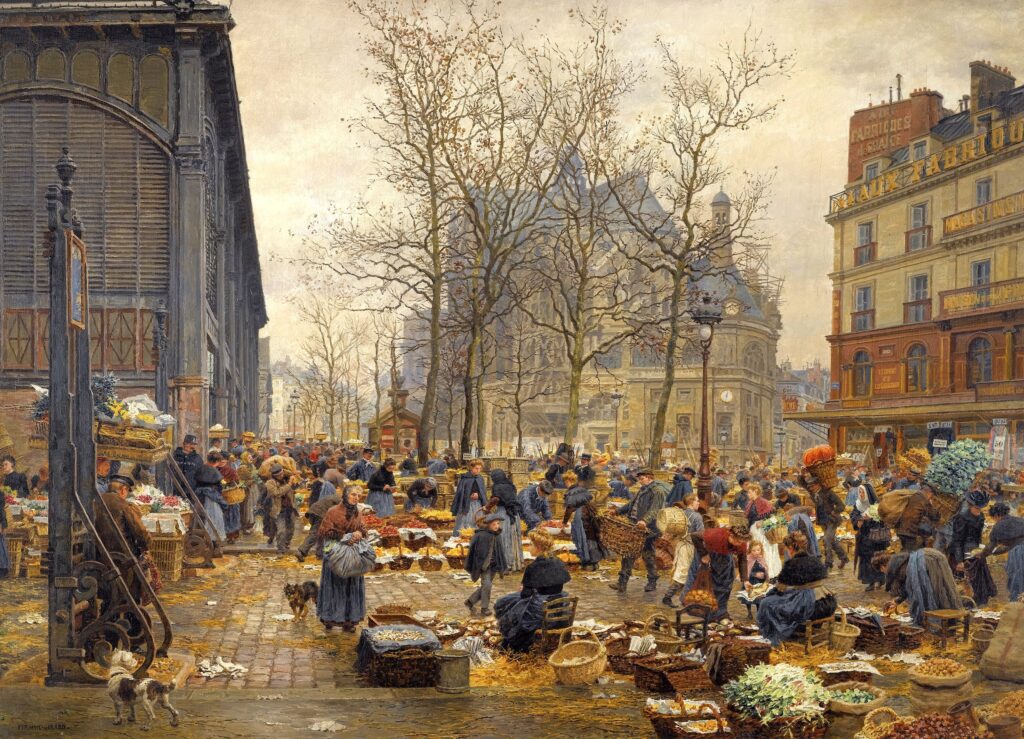
Marie-François Firmin-Girard, Autumn Market at Les Halles, ca. 1860 to 1910, private collection. Wikimedia Commons (public domain).
Marie-François Firmin-Girard, a distinguished French academic painter, gained acclaim for his elegant and meticulously detailed genre scenes that captured fashionable Parisian life during the Belle Époque (1871 to 1914), a golden age in Europe. Trained at the École des Beaux-Arts in Paris under the renowned academic painter Alexandre Cabanel, Firmin-Girard regularly exhibited at the prestigious Paris Salon.
Despite his adherence to principles of academic painting, Firmin-Girard’s compositions reveal an infusion of light and vibrancy, indicating that he was not impervious to the influence of Impressionism.
In a masterful display of his artistic prowess in this painting, he skillfully portrays a bustling market on a cold and wet autumn morning. The dampness of the ground and the bare trees signify the season, further established by warmly dressed figures navigating the scene.
The busy street comes alive with a multitude of shoppers inspecting produce, while sellers and their attendants maneuver goods through the crowded marketplace. The inclusion of litter and dogs scattered throughout the composition not only adds authenticity but also imparts a lived-in feeling, showcasing Firmin-Girard’s ability to capture the dynamic and authentic essence of everyday life.
DailyArt Magazine needs your support. Every contribution, however big or small, is very valuable for our future. Thanks to it, we will be able to sustain and grow the Magazine. Thank you for your help!